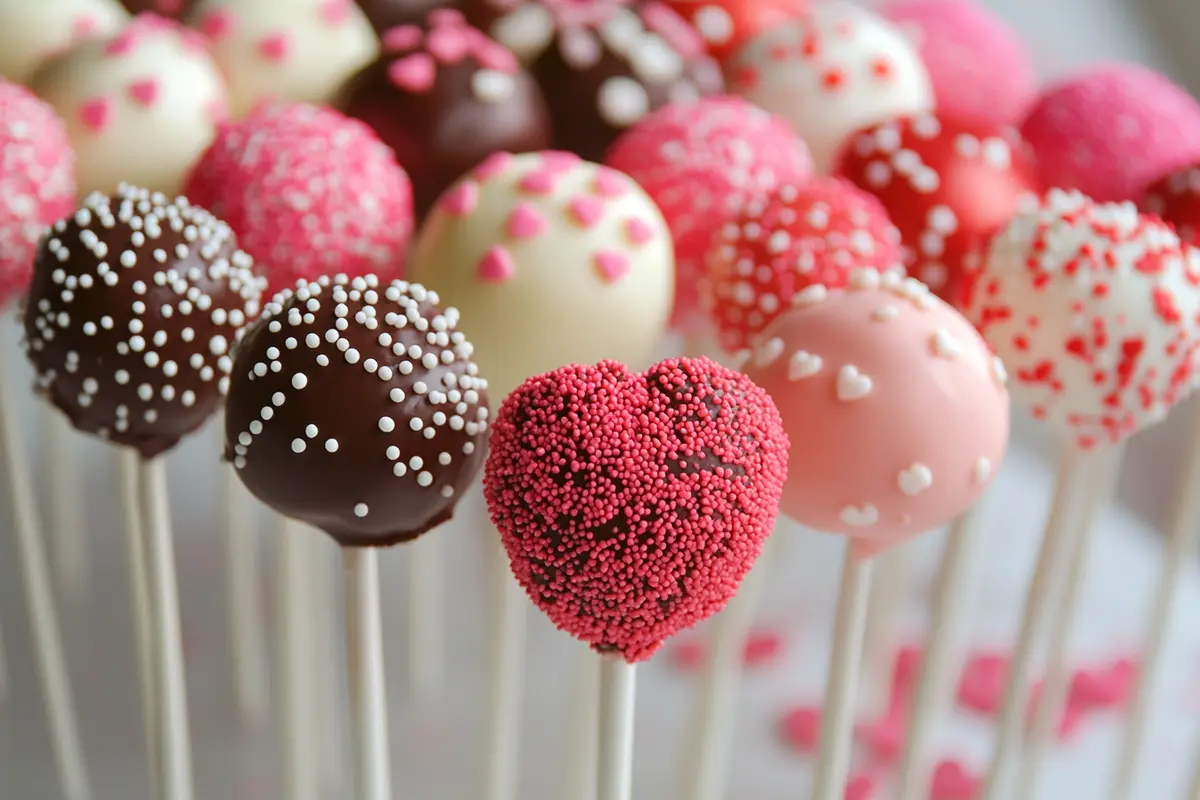Discover how to make delightful Valentine’s Day cake pops with this easy-to-follow recipe. Perfect for gifting or celebrating, these bite-sized treats are sure to impress!
Valentine’s Day is all about love, and what better way to express it than with homemade Valentine’s Day cake pops? These adorable, bite-sized desserts are not only delicious but also incredibly fun to make. Whether you’re planning a romantic dinner or looking for a creative gift, these cake pops will steal the show. In this article, we’ll guide you through everything you need to know about making Valentine’s Day cake pops, from ingredients and step-by-step instructions to tips and tricks for perfect results.
Why Valentine’s Day Cake Pops Are the Perfect Treat
Valentine’s Day cake pops are more than just desserts—they’re edible expressions of love. Here’s why they’re perfect for the occasion:
- Portable and Shareable: Their small size makes them ideal for parties or gifting.
- Customizable: You can decorate them in endless ways to match your Valentine’s theme.
- Kid-Friendly: Children love helping with the decorating process.
- Budget-Friendly: They’re affordable to make, even for large groups.
Ingredients for Valentine’s Day Cake Pops
To make about 30 cake pops, you’ll need:
- 1 box of vanilla or chocolate cake mix (plus ingredients listed on the box)
- 1 cup of frosting (store-bought or homemade)
- 2 cups of candy melts (pink, red, or white)
- 30 lollipop sticks
- Sprinkles, edible glitter, or other decorations
- 1 tablespoon of vegetable oil (to thin the candy melts)
Step-by-Step Instructions
1: Bake the Cake
- Prepare the cake mix according to the package instructions.
- Bake the cake in a 9×13-inch pan and let it cool completely.
2: Crumble and Mix
- Crumble the cooled cake into fine crumbs using your hands or a food processor.
- Add 1 cup of frosting to the crumbs and mix until the mixture holds together.
3: Shape the Cake Balls
- Roll the mixture into 1-inch balls and place them on a baking sheet.
- Chill the balls in the refrigerator for at least 30 minutes.
4: Insert the Sticks
- Melt a small amount of candy melts and dip the tip of each lollipop stick into it.
- Insert the sticks into the chilled cake balls.
5: Coat the Cake Pops
- Melt the remaining candy melts with a tablespoon of vegetable oil for a smooth consistency.
- Dip each cake pop into the melted candy, ensuring it’s fully coated.
- Decorate with sprinkles or edible glitter while the coating is still wet.
6: Let Them Set
- Place the decorated cake pops upright in a styrofoam block or cake pop stand.
- Allow them to set completely before serving or packaging.
Tips
- Chill the Cake Balls: This prevents them from falling apart when dipping.
- Use High-Quality Candy Melts: They provide a smoother finish and better flavor.
- Avoid Over-Mixing: Too much frosting can make the cake pops too dense.
- Work Quickly: Candy melts harden fast, so decorate immediately after dipping.
Creative Decoration Ideas
Make your Valentine’s Day cake pops stand out with these fun and festive decoration ideas:
- Heart-Shaped Sprinkles: Add a romantic touch with red and pink heart-shaped sprinkles.
- Edible Glitter: Give your cake pops a shimmering effect with edible glitter.
- Personalized Messages: Use edible markers to write sweet messages like “Be Mine” or “XOXO.”
- Ombre Effect: Dip the cake pops in gradient shades of pink and red for a trendy look.
- Mini Flags: Attach tiny paper flags with cute Valentine’s Day quotes.
How to Package Valentine’s Day Cake Pops for Gifting
Presentation is key when gifting Valentine’s Day cake pops. Here are some packaging ideas:
- Clear Cellophane Bags: Wrap each cake pop individually and tie it with a ribbon.
- Mini Mason Jars: Arrange cake pops in small jars for a rustic look.
- Gift Boxes: Use heart-shaped boxes or small gift boxes lined with tissue paper.
- DIY Wrapping: Create custom wrappers using Valentine’s Day-themed paper.
Common Mistakes to Avoid When Making Valentine’s Day Cake Pops
Even experienced bakers can run into issues when making cake pops. Here are some common mistakes and how to avoid them:
- Skipping the Chilling Step: Not chilling the cake balls can cause them to fall apart during dipping. Always refrigerate for at least 30 minutes.
- Using Too Much Frosting: Over-mixing the cake crumbs with frosting can make the pops too dense and heavy. Stick to the recommended amount.
- Thick Coating: If the candy melts are too thick, the coating will crack. Add a small amount of vegetable oil to thin it out.
- Rushing the Process: Take your time when dipping and decorating to ensure a smooth, even finish.
Benefits of Making Valentine’s Day Cake Pops
- Creative Outlet: Decorating cake pops allows you to express your creativity.
- Bonding Activity: Making them with loved ones creates lasting memories.
- Healthier Option: You control the ingredients, making them a healthier treat.
- Cost-Effective: Homemade cake pops are cheaper than store-bought ones.
Nutritional Information
Here’s the nutritional content per 100g of Valentine’s Day cake pops:
| Nutrient | Amount |
|---|---|
| Calories | 350 kcal |
| Carbohydrates | 45g |
| Protein | 3g |
| Fat | 18g |
| Sugar | 30g |
| Fiber | 1g |
Frequently Asked Questions (FAQs)
What is the trick to cake pops?
The key to perfect cake pops is chilling the cake balls before dipping them. This ensures they hold their shape and don’t fall apart.
What’s in the Valentine’s cake pop?
Valentine’s Day cake pops typically include crumbled cake mixed with frosting, coated in candy melts, and decorated with festive sprinkles or edible glitter.
Are cake pops expensive?
No, cake pops are budget-friendly, especially when made at home. The ingredients are affordable, and you can make a large batch at once.
Is it better to make cake pops the day before?
Yes, making cake pops a day ahead allows them to set properly and enhances their flavor.
What not to do when making cake pops?
Avoid over-mixing the cake and frosting, as this can make the pops too dense. Also, don’t skip chilling the cake balls.
What causes cake pops to crack?
Cracks occur if the cake balls are too dry or if the coating is too thick. Adding a bit of frosting and thinning the candy melts can help.



